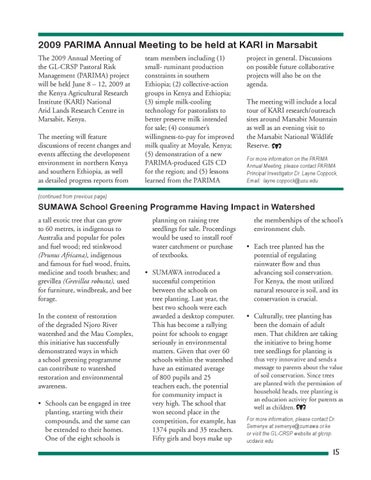2009 PARIMA Annual Meeting to be held at KARI in Marsabit The 2009 Annual Meeting of the GL-CRSP Pastoral Risk Management (PARIMA) project will be held June 8 – 12, 2009 at the Kenya Agricultural Research Institute (KARI) National Arid Lands Research Centre in Marsabit, Kenya. The meeting will feature discussions of recent changes and events affecting the development environment in northern Kenya and southern Ethiopia, as well as detailed progress reports from
team members including (1) small- ruminant production constraints in southern Ethiopia; (2) collective-action groups in Kenya and Ethiopia; (3) simple milk-cooling technology for pastoralists to better preserve milk intended for sale; (4) consumer’s willingness-to-pay for improved milk quality at Moyale, Kenya; (5) demonstration of a new PARIMA-produced GIS CD for the region; and (5) lessons learned from the PARIMA
project in general. Discussions on possible future collaborative projects will also be on the agenda. The meeting will include a local tour of KARI research/outreach sites around Marsabit Mountain as well as an evening visit to the Marsabit National Wildlife Reserve. For more information on the PARIMA Annual Meeting, please contact PARIMA Principal Investigator Dr. Layne Coppock, Email: layne.coppock@usu.edu
(continued from previous page)
SUMAWA School Greening Programme Having Impact in Watershed a tall exotic tree that can grow to 60 metres, is indigenous to Australia and popular for poles and fuel wood; red stinkwood (Prunus Africana), indigenous and famous for fuel wood, fruits, medicine and tooth brushes; and grevillea (Grevillea robusta), used for furniture, windbreak, and bee forage. In the context of restoration of the degraded Njoro River watershed and the Mau Complex, this initiative has successfully demonstrated ways in which a school greening programme can contribute to watershed restoration and environmental awareness. • Schools can be engaged in tree planting, starting with their compounds, and the same can be extended to their homes. One of the eight schools is
planning on raising tree seedlings for sale. Proceedings would be used to install roof water catchment or purchase of textbooks. • SUMAWA introduced a successful competition between the schools on tree planting. Last year, the best two schools were each awarded a desktop computer. This has become a rallying point for schools to engage seriously in environmental matters. Given that over 60 schools within the watershed have an estimated average of 800 pupils and 25 teachers each, the potential for community impact is very high. The school that won second place in the competition, for example, has 1374 pupils and 35 teachers. Fifty girls and boys make up
the memberships of the school’s environment club. • Each tree planted has the potential of regulating rainwater flow and thus advancing soil conservation. For Kenya, the most utilized natural resource is soil, and its conservation is crucial. • Culturally, tree planting has been the domain of adult men. That children are taking the initiative to bring home tree seedlings for planting is thus very innovative and sends a message to parents about the value of soil conservation. Since trees are planted with the permission of household heads, tree planting is an education activity for parents as well as children. For more information, please contact Dr. Semenye at semenye@sumawa.or.ke or visit the GL-CRSP website at glcrsp. ucdavis.edu.
15
